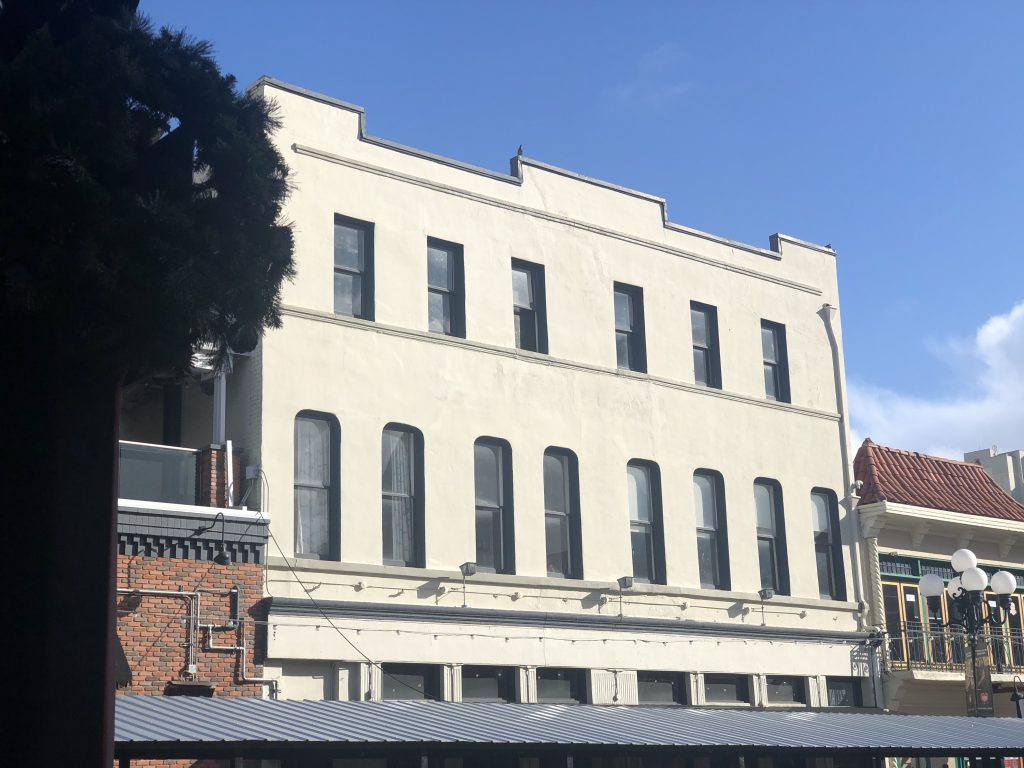No products in the cart.
Landmarks
Many Things for Many People – Tin to Tacos
The Higgins-Begole Building
(1873 – 1906 – 1921)
529 5th Avenue
Architectural Style: Art Deco
Architect: Payne and Lacey
In the 1840s, many young men were heading west, hopefully to make their fortune in the newly discovered gold fields in San Francisco and Sacramento. William Augustus Begole was no exception. In the 1852 California State Census, he was listed as a “miner” living in Calaveras County, but by 1855, he had settled in Red Dog Digging, Nevada. Mr. Begole seemed to do quite well in Red Dog, as he became a successful businessman, property owner and civic leader. He had learned the tinsmith trade and opened a hardware store.
W. A. Begole, with his chief partner and cohort, Dr. D. A. Crane, also ventured into hydraulic mining, supplying water to miners and politics. He and Dr. Crane and others went to the American Party National Convention, where due to disagreements regarding immigration and anti-Catholicism, the party split. Begole, Crane and others returned to Red Dog as newly minted Republicans.
By 1857, his Begole and Company mining claims were paying big. He further expanded his holdings by lending money and taking miners’ claims as collateral. He built a 300-seat theater, and became a Board Member of the newly formed Red Dog Fire Department.
Although Begole was doing very well, Red Dog was not. Throughout the 1860s, it was beset by numerous natural disasters, including two calamitous fires during which the theater was destroyed, and torrential rains and flooding, which practically wiped the town off the map. Begole headed south to San Diego.
He arrived in San Diego on September 24, 1868, with gold in his pocket, his tin smithing trade, Masonic connections and Republican credentials – all very good things to have in Alonzo Horton’s Newtown. He promptly purchased a double lot at 529 Fifth Avenuewith plans to open a tin shop. Within weeks, Begole aligned himself with Horton, Horton’s brother-in-law, Ned Bushyhead, publisher of the San Diego Union, Joseph Nash, Lewis and Douglas Gunn and lawyer brothers, Daniel and William Cleveland. These men, all known as the “69ers,” remained his life-long friends.
In 1869, Begole constructed a one-story brick building for his stove, hardware, plumbing and tin business. It is the oldest documented brick structure in the Gaslamp. In 1878, he added a second story, and in 1886 , a third story was added. It was ultimately described by the San Diego Union as “a handsome building with a fine iron front, large shop windows and galvanized iron cornices.”
To the right, T.J. Higgins, a dealer in real estate and insurance, built a two-story brick edifice in 1873. It was designed by early San Diego architects, Payne and Lacey, and featured an iron front and was said to be completely fireproof. The San Diego Union also stated that it was “one of the handsomest buildings on 5th.” Payne and Lacey additionally designed Old City Hall and the Nesmith-Greeley Building. Upon completion, Higgins used a portion of the building for his real estate business, and rented the rest to Steiner and Klauber, who sold groceries, dry goods and hardware. They remained until 1877, and the Fashion Saloon then moved into the downstairs. They were followed in 1881 by Philips and Eisen, who operated a wholesale business dealing in wine, liquor, cigars and tobacco. The cigars were actually made from tobacco grown in San Diego County! From 1882 until 1887, the Star Restaurant downstairs advertised that they offered “nice furnished rooms to let upstairs in the Higgins Brick Block. It was also reputed to be a brothel. Higgins, in the meantime, decided to go into the whaling business, and moved his base of operations to the peninsula opposite Ballast Point.
In 1921, both facades of the buildings were joined making it appear as one. The upper floors have a history as rented rooms or a small hotel, and the lower floors usually ran billiards parlors. Frank S. Kaneko and Kenjiro Yamamoto both ran billiards parlors on the first floor of the buildings from 1906 until 1909, with Y. Masumoto and T. Uyezi continuing through 1917. The Hotel Togo, run by T. O. Kusu, offered rooms in the Higgins Building from 1916 until1919, when it was taken over by Mrs. Venni Lolani and operated as the Hawaiian Hotel from 1921 until 1958. In the Begole Building, George Ramsey and his wife, Rena, ran the Oakland Hotel from 1924 until 1927. George was known as San Diego’s Mayor of Harlem, as he was the proprietor of the Creole Palace, known as the Cotton Club of the West. The Creole Palace, in the Douglas Hotel, was on Second and Market Streets. On the first floor, the Hong Kong Cafe, serving chop suey and chow mien, was under the direction of Lim and Gladys Lee from 1927-37, and George Obayashi operated the restaurant from 1938 through 1941. Afterwards, the space was occupied by various Mexican eateries on the lower floors until 1959, when the entire building was taken over by the San Diego Rescue Mission. The Rescue Mission, serving San Diego’s homeless, remained until 1985. In 1988, the building was purchased by Martin and Cindy Blair, early Gaslamp restoration pioneers. After an extensive renovation, they opened the Kansas City Steak House and Stingaree Saloon.
The building now houses Volcano Rabbit, a Mexican restaurant and craft tequila bar.
Sandee is the historian and lead tour guide for the Gaslamp Quarter Historical Foundation. She can be reached at [email protected]

